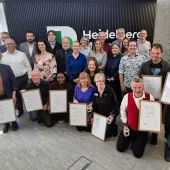CEMEX Site Biodiversity and Quarry Restoration

First published in the May 2021 issue of Quarry Management as Challenges and Opportunities
Sean Cassidy, regional environmental manager at CEMEX UK, provides an insight into how the business is ensuring site biodiversity and restoration remain a priority despite current challenges
The coronavirus pandemic has certainly presented CEMEX UK with many challenges which have impacted the whole business, not just operations, but also our biodiversity and sustainability efforts too. The company made the decision to continue to operate throughout, although some of the restoration and conservation work planned for 2020 had to be delayed, to ensure people stayed safe.
However, once Covid safety protocols were introduced to keep employees and contractors safe, the quarries started some of the planned work and around 25ha was restored during 2020, including some UK Biodiversity Action Plan (BAP) priority habitat at West Heath Quarry, in West Sussex. We were also able to continue with routine maintenance around our landholdings; we have a significant amount of habitat of conservation status to maintain.
The pandemic also presented opportunities from a biodiversity perspective. For instance, it allowed us to take a closer look at biodiversity in our urban sites and the results were surprisingly good; at Jarrow Wharf in Tyne & Wear, we spotted a total of 248 species over the summer, including 97 types of wildflower and 63 species of invertebrate. The wildlife here thrives because of the way the site is managed – with some areas left undisturbed and others regularly changed. This creates conditions for a wide variety of species.
A key lesson learned from this experience was that urban sites can offer just as much scope for biodiversity as some of our restored quarries. In response, we have revised our Biodiversity Standard to include management plans tailored to suit sites in built-up locations.
This demonstrates that it has been possible to continue biodiversity work despite the pressures of the pandemic, and it is vital that these efforts continue to be a priority as lockdown measures ease and things begin to return to the ‘new normal’. There is a greater awareness within society of issues centred around the global loss of biodiversity, and indeed the impact of the coronavirus pandemic has probably given people more time to think about the problem and prioritize it as we go forward.
Sustainability as a whole has come of age, and with the likes of Greta Thunberg and the global environmental movement group Extinction Rebellion, everyone is more aware of the issues facing our planet. Within CEMEX we have a duty to look at everything we do and assess it in the light of its environmental impact.
During 2020 CEMEX negotiated a new financing package which included a number of sustainability criteria as part of the agreement. This included biodiversity management and we are now in the process of producing new management plans for more sites as part of this deal. It demonstrates the importance given to biodiversity, not just by the aggregates industry itself, but by our shareholders and financial backers. UK legislation is also driving change, with large sections of the new Environment Bill focusing on Biodiversity Net Gain and conservation covenants. This focus has ensured biodiversity remains a priority in relation to decision-making around conservation work at quarries.
As a business we have a long-standing relationship with the RSPB and the work we do together continues to deliver priority habitat as well as species protection. It also demonstrates our continued commitment to enhancing and improving the biodiversity at our sites.
When considering the biodiversity of our quarries and the work to be done, it is important to recognize the impact this has on the wider sustainability goals of the organization. Sustainability means meeting the needs of the present without compromising the needs of the future. When you think about sustainability and link it to biodiversity you are naturally drawn to the concept of ecosystem services. A lot of the issues that sustainability is trying to address are related to loss of habitat and land degradation. By creating natural habitat – woodland or calcareous grassland, as examples, you are addressing sustainability issues such as climate change, water, or air pollution. Relating this back to ecosystem services – woodland can absorb greenhouse gases, purify air, percolate water, and protect priority species.
The restored habitat also offers communities access to an area where they can enjoy the wildlife or even simpler pleasures such as walking the dog. Restored quarries have a successful track record with many becoming nature reserves and some with SSSi status. Prioritizing biodiversity certainly affects the sustainability of our operations and we are keen to start to measure this going forward, so we can quantify the positive impact.
As CEMEX UK’s biodiversity specialist, I have seen how biodiversity has become more important and more central for sustainability over the last 10 years. Our whole business relies on our sustainable credentials and our biodiversity work feeds into this. Currently, there is a lot of focus on climate change, so the potential for natural habitats to absorb carbon and help regulate the carbon cycle will be something we really concentrate on as part of our business’s plans to achieve Net Zero by 2050.
The new Biodiversity Net Gain requirement in the Environment Bill will also, for the first time, introduce a direct cost for causing a loss to biodiversity, but more importantly, also offers the potential to benefit from creating a net gain at your site. The new requirement will almost certainly increase the importance attached to biodiversity and how this links to sustainability more generally. The recently published Dasgupta Report is likely to help thinking around the cost to nature due to our activities and lifestyles, similar to the way that the Stern Report framed thinking around the price of carbon and its impact on climate change. Measuring natural capital and the benefits restored sites can bring will almost certainly become a central part of sustainability plans going forward.
Looking at the year ahead, CEMEX are optimistic about getting back to business as usual despite the challenges of the past 12 months. In terms of restoration, we have some major projects planned and, with help from the RSPB, remain on track to create 1,500ha of priority habitat.
We have ongoing projects to prioritize protected species, including twite, turtle dove, bittern and the small blue butterfly. We have also started on new protected species projects including one for the willow tit, which has seen large decreases in numbers over recent years.
With our newly updated Biodiversity Standard we are also really keen to develop plans in urban locations which help species we all know, such as hedgehogs, house sparrows, swifts and starlings, but which have struggled lately. Some of our sites in urban locations can offer nature a long-term habitat and we feel it is important to capture this opportunity.
Certainly, while it has been a difficult period for us all, it is exciting to look ahead and focus on how we can improve the habitat and biodiversity of the areas in which we work; remembering our responsibility as a mineral extraction company to leave the world in a better state than we find it.
Case Study – Swifts at Salford Asphalt Plant
Swifts are the perfect house guest. They are only in the UK for three months of the year, make no mess when nesting and help get rid of flying insects and mosquitoes.
Sadly, their numbers have been rapidly declining, due in part to the lack of suitable nest locations in our urban environments, largely because of renovations and changes in roofing techniques.
A new home for swifts (a swift tower) was erected at CEMEX’s busy asphalt plant in Hope Street, Manchester, to encourage this charismatic bird to nest. During May, swifts return to UK towns and cities and are a quintessential sign of the British summer.
The swift tower at the plant can help provide a home for up to 12 swifts. Swifts are unusually hesitant deciding on a new home, so the new tower incorporates a caller (a pre-recorded sound of a swift’s call) that plays at dusk and dawn to encourage new occupants to move in.
Case Study – Choughs at Raynes Quarry
At Raynes Quarry in Wales, CEMEX are protecting red-billed choughs that are breeding on site and engaging with the RSPB to create new feeding habitat for these birds.
Choughs like to nest in crevices in rock, and the quarry walls provide a great alternative to the nearby sea cliffs. As the rarest members of the crow family, the red-billed chough has a history of persecution in the UK – egg theft still occurs and they have been impacted by the decline in species-rich unimproved grasslands and the use of insecticides – and now their range is entirely restricted to the west coast.
Nesting sites are, therefore, vitally important to protect. Working with a chough expert, CEMEX are restoring species-rich chalk grassland – feeding grounds favoured by choughs – surrounding the quarry.
Working with the RSPB, CEMEX staff have been involved in monitoring the nature at the site. This includes surveys and plans for habitat creation for the rare silver-studded blue butterfly, another target species of the biodiversity management plan, whose range in Wales is mostly limited to the northern fringe of the country, where the quarry is located.
- Subscribe to Quarry Management, the monthly journal for the mineral products industry, to read articles before they appear on Agg-Net.com








